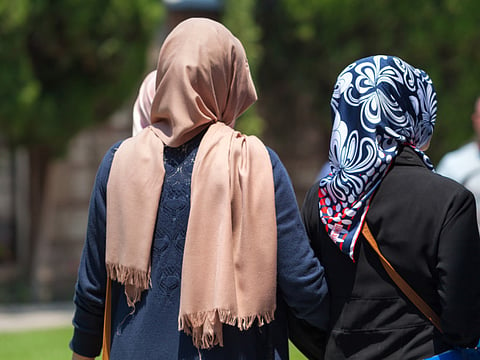Australian Muslim women don’t have to be told what to wear
For an exclusive brand of white mainstream feminism the only acceptable Muslim woman is the one where her ‘Muslimness’ is erased

The rise of “modest fashion”, both in Australia and overseas, is part of a larger fashion revolution that understands the economic incentives of diversity. CoverGirl features hijabi beauty vlogger Nura Afia as their model, while Mariah Idrissi became the first model wearing a hijab for H&M in 2015. It is a lucrative market. The modest fashion empire is set to be worth more than $368 billion (Dh1.35 trillion) by 2021. It’s a market that holds untapped opportunities for Australia’s cotton and clothing industries, industries that would welcome growth.
The Department of Foreign Affairs and Trade (Dfat) recently issued a press release highlighting that they had facilitated an Australian fashion exhibition focusing on modest clothing in one of south-east Asia’s major consumers of modest fashion.
There was swift criticism by those who continue to hold ill-informed and poor understandings of terrorism and radicalisation, by those who lack a basic understanding of soft power and diplomacy, by the prejudiced and those ignorant of intersectional feminism (in some criticisms, all four were apparent). Former prime minister Tony Abbott, urged Dfat to “focus on mainstream Australia”. This is the same man who politicised national security and not only ignited, but poured petrol on the relationship between Australian Muslims and law enforcement (one which is still being rebuilt).
Where they talk of the liberation and freedom of Muslim women, but are silent on Ahed Tamimi. We know that this exclusive brand of white mainstream feminism isn’t really about an all-inclusive sisterhood.
The photograph of the 14 young, smiling and beautiful Australian women issued as part of Dfats’s press release was soon appropriated and splashed on the front page of a mainstream newspaper with the catch cry that it “does not represent us”. The criticisms perfectly demonstrate how there is an incessant fetishisation of Muslim women in Australia; how multiculturalism is now viewed as a dirty word. The war on terror has made what Muslim women wear a constant accusation of misogyny and violent extremism as instrumental in orgies of violence and terror. It’s an accusation that despite what mainstream media and self-elected community leaders demand, Muslim women have no onus to defend or explain. It has been painful to watch the various public performances acted out by Australian Muslims as a means to demonstrate their humanity: Date a muslim, hug a muslim, wear a hijab and dress as a muslim, handing out roses and sausage sizzles.
The accusation that religious garments are a precursor to radicalisation or violent extremism is one that has no grounds in the extensive body of terrorism literature. Respected terrorism experts have found that there are no links between modest clothing and violent extremism or terrorism; indeed, that religion is not a sole or major contributor to violent extremism. The fact that this is so widely believed and espoused by politicians and other stakeholders reveals just how pervasive the politicisation of national security has become, risking the continued use of national security policy being a political play thing or a way to raise revenue for mainstream publications. This is dangerous, divisive and frankly unacceptable. If religion is believed to be the precursor for radicalisation and terrorism and adopted as a policy by security and law enforcement agencies, it would result in discriminatory practices. Arguably, Australian Muslims are already at the receiving end of such practices.
Australian Muslim women live in a country where national security policies intersect and collide with feminism with increasing regularity. Our bodies and clothing are a form of currency and radicalisation indicators, traded for countering violent extremism grants and the sale of newspapers and votes. Australia has many faces that we show to the world. It is increasingly becoming one of racism; where “whiteness” is seen to be in peril, in danger of being diluted or driven to extinction.
It is common for female public figures in Australia to build their careers and their egos off the backs of Muslim women. Where they talk of liberation while being silent on Nauru, Manus or even Yemen or Syria. Where they talk about the public display of violence, but are silent about Australia exporting arms. Where they talk of being enlightened, but are silent about the noose being placed around the neck of press freedoms in our country. Where they talk of the liberation and freedom of Muslim women, but are silent on Ahed Tamimi. We know that this exclusive brand of white mainstream feminism isn’t really about an all-inclusive sisterhood. It is also increasingly common for Muslim women to point the finger at more conservative Muslim women in the community, so eager are they to be seen as “one of the good ones”, as an example of how it is possible to be both Australian and to wear the veil. We know that for these feminists, the only acceptable Australian Muslim woman is one where her “Muslimness” is erased.
Australian Muslim women have done very well without being told what they can wear, “from day dot”, as Caroline Overington puts it in her opinion piece. And indeed, it is because Australian Muslim womanhood is “robust, hands-on, shoulder to the wheel”. We are resilient and savvy in negotiating political waters. Fashion has always been avant garde. When does fashion represent a far more inclusive and collaborative face of Australian than its social and political institutions? In 2018, apparently.
— Guardian News & Media Ltd
Lydia Shelly is a lawyer, hijabista and masters student in Terrorism and Security Studies at Charles Sturt University.
Sign up for the Daily Briefing
Get the latest news and updates straight to your inbox



